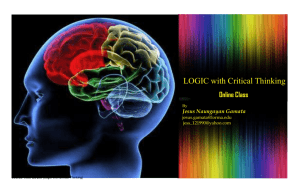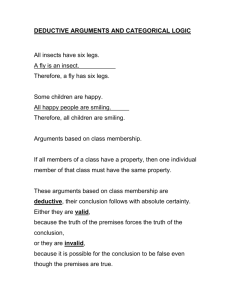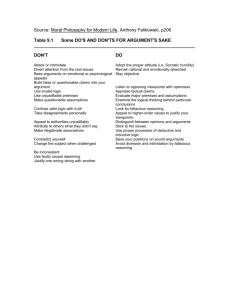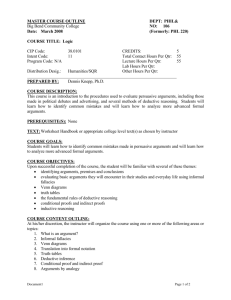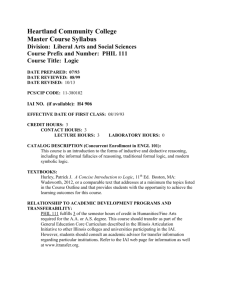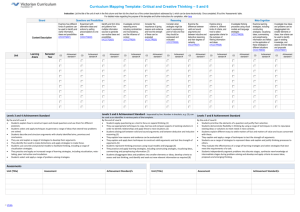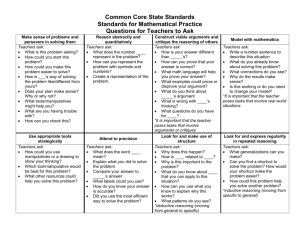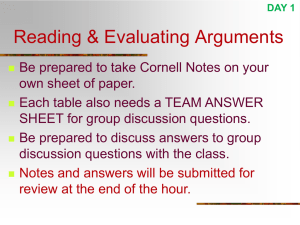CCC8001 Logic and Critical Thinking
advertisement
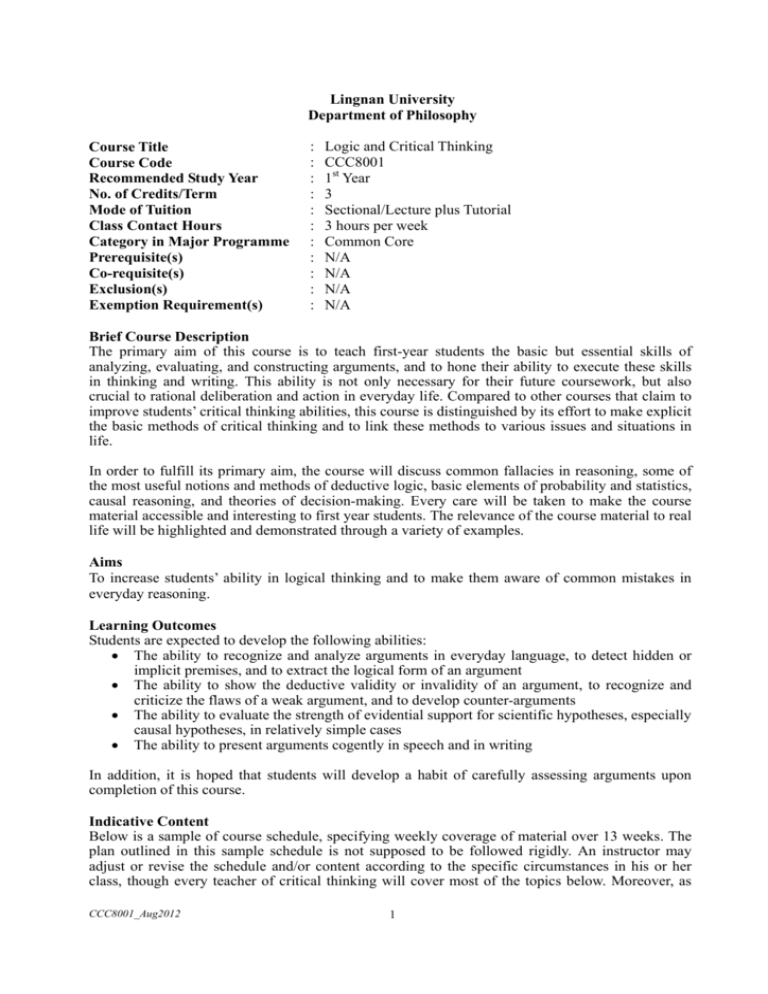
Lingnan University Department of Philosophy Course Title Course Code Recommended Study Year No. of Credits/Term Mode of Tuition Class Contact Hours Category in Major Programme Prerequisite(s) Co-requisite(s) Exclusion(s) Exemption Requirement(s) : : : : : : : : : : : Logic and Critical Thinking CCC8001 1st Year 3 Sectional/Lecture plus Tutorial 3 hours per week Common Core N/A N/A N/A N/A Brief Course Description The primary aim of this course is to teach first-year students the basic but essential skills of analyzing, evaluating, and constructing arguments, and to hone their ability to execute these skills in thinking and writing. This ability is not only necessary for their future coursework, but also crucial to rational deliberation and action in everyday life. Compared to other courses that claim to improve students’ critical thinking abilities, this course is distinguished by its effort to make explicit the basic methods of critical thinking and to link these methods to various issues and situations in life. In order to fulfill its primary aim, the course will discuss common fallacies in reasoning, some of the most useful notions and methods of deductive logic, basic elements of probability and statistics, causal reasoning, and theories of decision-making. Every care will be taken to make the course material accessible and interesting to first year students. The relevance of the course material to real life will be highlighted and demonstrated through a variety of examples. Aims To increase students’ ability in logical thinking and to make them aware of common mistakes in everyday reasoning. Learning Outcomes Students are expected to develop the following abilities: The ability to recognize and analyze arguments in everyday language, to detect hidden or implicit premises, and to extract the logical form of an argument The ability to show the deductive validity or invalidity of an argument, to recognize and criticize the flaws of a weak argument, and to develop counter-arguments The ability to evaluate the strength of evidential support for scientific hypotheses, especially causal hypotheses, in relatively simple cases The ability to present arguments cogently in speech and in writing In addition, it is hoped that students will develop a habit of carefully assessing arguments upon completion of this course. Indicative Content Below is a sample of course schedule, specifying weekly coverage of material over 13 weeks. The plan outlined in this sample schedule is not supposed to be followed rigidly. An instructor may adjust or revise the schedule and/or content according to the specific circumstances in his or her class, though every teacher of critical thinking will cover most of the topics below. Moreover, as CCC8001_Aug2012 1 already noted, instructors will choose various forms of activity to supplement lectures and reinforce learning of the material. Week 1 General Introduction An overview of the course is given, including, but not limited to, the importance and distinctive virtues of critical thinking, and the course mechanics. Week 2 Arguments and Definitions Arguments are introduced as the primary linguistic form of reason-giving and inference-making, and as the central object for identification, analysis, and evaluation in critical thinking. Ambiguity and vagueness are noted as two features of language that may cause confusions and give rise to faulty reasoning. This motivates a study of definitions: the importance of defining concepts for clear thinking, and the different kinds of definitions. Week 3 Different Kinds of Arguments An overview of different kinds of arguments and their respective evaluative criteria is presented, with a special emphasis on the distinction between arguments that are intended to be deductive (where the conclusion logically follows from the premises) and arguments that are intended to be inductive (where the conclusion contains more information than is contained in the premises). More exercises are done with respect to recognizing arguments, especially arguments with hidden or suppressed premises. Argument mapping is introduced as an effective tool for analyzing and constructing arguments. Week 4 Deductive Logic I The evaluative criterion for deductive arguments – the concept of deductive validity – is further explained, which is roughly that the truth of the premises of an argument guarantees the truth of the conclusion of the argument. The basic symbolism of sentential logic (the kind of logic that studies arguments at the level of sentences) is introduced, as well as the truth table method for showing the validity or invalidity of an argument. Week 5 Deductive Logic II A system for making deductive inferences called natural deduction is introduced. How to use natural deduction to justify arguments and draw implications is demonstrated, together with the operation of natural deduction in everyday reasoning. Week 6 Deductive Logic III The most useful valid rules for quantificational reasoning (reasoning about such quantifiers as all, every, some, none, etc.) are presented and explained. To set up a contrast, a sample of invalid arguments involving quantifiers is presented. (The possibility of rigorously studying such reasoning in predicate logic will be mentioned, but for the sake of accessibility, the formalism of predicate logic will not be taught in this course.) CCC8001_Aug2012 2 Week 7 Mid-term Review The materials covered in the previous weeks are reviewed, and more examples are used to apply logical methods to real life cases: exercises may include logical games, standard tests, and/or debates. As a way to motivate the second half of the course, the limitations of deductive logic are explained. Week 8 Inductive Reasoning I Different types of inductive reasoning are illustrated, including analogical reasoning, statistical inference, and inference to the best explanation. The role of probability in carrying out and evaluating inductive inference is highlighted, and very elementary rules of probability are explained. Common fallacies in assessing probability are also noted. Week 9 Inductive Reasoning II Bayesian inference, a kind of reasoning that incorporates opinions before certain data are collected with information conveyed by the data, is introduced in an elementary and accessible fashion. Common pitfalls in Bayesian inference are illustrated with examples from diverse fields. If there is time, the notion of utility and the principle of expected utility for decision making will be introduced. Week 10 Inductive Reasoning III Basic terminology in descriptive statistics is explained. The focus is placed on how to understand and use statistical information, including poll results and hypothesis test results, as commonly seen in newspapers and scientific publications. Week 11 Inductive Reasoning IV The difference between causation and correlation is highlighted with examples such as the socalled Simpson paradox. Common pitfalls in causal inference are presented, as well as the virtues of controlled experiments. The role of randomization (as in typical clinical trials) is examined, together with the possibility of inferring causation from patterns of correlations. Week 12 Fallacies As a final attempt to warn students against fallacious reasoning, the instructor systematically surveys all previously mentioned fallacies and introduces additional ones, illustrated by real examples from newspaper articles, public debates and speeches, and scientific reports, etc. Week 13 Course Review Teaching Method Instructors may choose to teach the course in a lecture/tutorial or a sectional approach. In either case, instructors are expected to give accessible lectures, and in addition, to provide ample opportunities for students to apply the methods and strategies under discussion in concrete settings. The relevant activities may take various forms, including, for example, the analysis and evaluation CCC8001_Aug2012 3 of arguments from real life sources (newspaper articles, TV programs, advertisements, real court or political debates, etc.); in-class debates on popular social and political issues; group or individual research projects in which students are asked to find arguments/evidence relevant to an issue and to compose an informed and well-argued critical essay. Measurement of Learning Outcomes Students’ progress towards the learning outcomes will be measured by their participation and performance in various class and/or online activities, which reflect their ability to apply the logical notions and methods to real cases, and their willingness to engage in critical thinking their written assignments, in which students reveal their ability to explain course material and present arguments in writing closed-book exams, which test students’ grasp and memory of course material and their ability to think through and solve problems . Assessment 60% Continuous assessment (possible forms include exercises, quizzes, short written reports, critical essays, midterm exam, and class participation) 40% Final examination Required Readings M.H. Salmon, Introduction to Logic and Critical Thinking, 5th ed., Wadsworth, 2007. Supplementary Readings D. N. Walton, Informal Logic, Cambridge University Press, 1989. I. Hacking, An Introduction to Probability and Inductive Logic, Cambridge University Press, 2001. CCC8001_Aug2012 4
